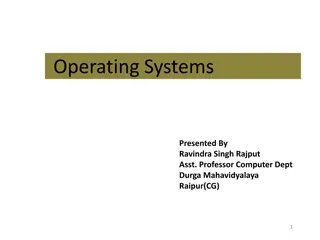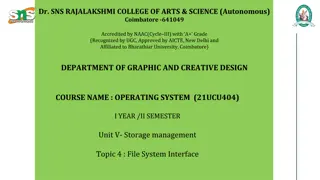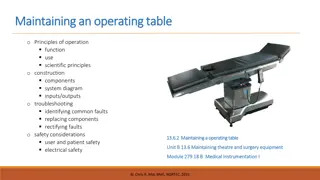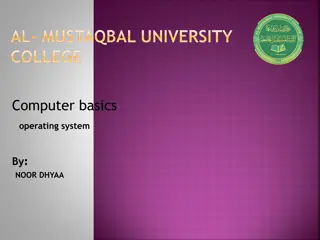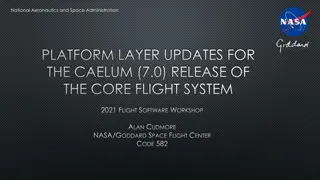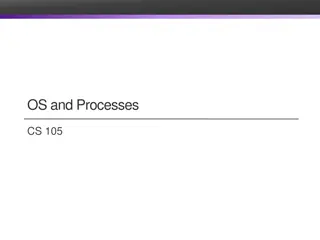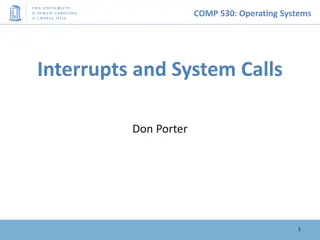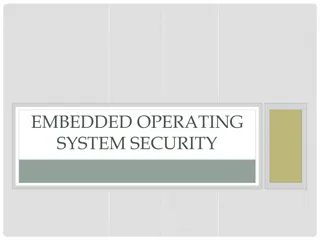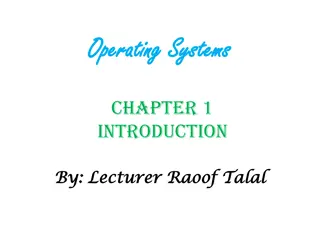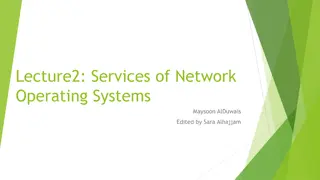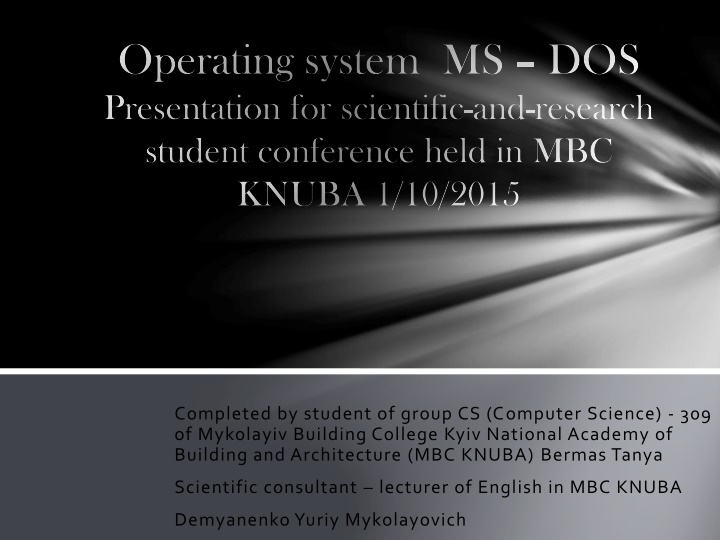
History and Impact of MS-DOS Operating System
A comprehensive overview of the MS-DOS operating system, its development by Microsoft, impact on computing history, and its role as a precursor to modern graphical user interface systems like Windows. MS-DOS was a pivotal disk operating system used on IBM PC-compatible computers in the 80s and 90s, serving as a foundational platform for subsequent Windows versions. The article covers its evolution, major releases, and its continued relevance as a boot loader for later Windows OS versions.
Download Presentation

Please find below an Image/Link to download the presentation.
The content on the website is provided AS IS for your information and personal use only. It may not be sold, licensed, or shared on other websites without obtaining consent from the author. If you encounter any issues during the download, it is possible that the publisher has removed the file from their server.
You are allowed to download the files provided on this website for personal or commercial use, subject to the condition that they are used lawfully. All files are the property of their respective owners.
The content on the website is provided AS IS for your information and personal use only. It may not be sold, licensed, or shared on other websites without obtaining consent from the author.
E N D
Presentation Transcript
Operating system MS DOS Presentation for scientific-and-research student conference held in MBC KNUBA 1/10/2015 Completed by student of group CS (Computer Science) - 309 of Mykolayiv Building College Kyiv National Academy of Building and Architecture (MBC KNUBA) Bermas Tanya Scientific consultant lecturer of English in MBC KNUBA Demyanenko Yuriy Mykolayovich
MS -DOS MS-DOS (Eng.) Microsoft Disk Operating System) is a disk operating system for computers based on x86 architecture. MS-DOS is the most famous OS in the family DOS-compatible operating systems and the most used among IBM PC-compatible computers during the 80s and until the mid 90-ies, until it was superseded operating systems with a graphical user interface, mainly from the family of Microsoft Windows.
In 1981, IBM has placed a request to create an operating system that was to be used in a new family of computers the IBM PC. Microsoft bought the rights to the operating system 86-DOS Computer Products[2] and began work on its modification under the requirements of IBM. Subsequently, IBM licensed MS-DOS released in August 1981 under the name PC-DOS 1.0. In a further development of MS-DOS and PC DOS were conducted Microsoft and IBM together until 1993, when they were issued two separate release 6.0 6.1 from Microsoft and IBM. from Seattle and was
During the existence of MS-DOS was released eight major releases (1.00, 2.00, etc.) and two dozen intermediate (3.10, 3.30, etc.), while in 2000, Microsoft has not stopped its development. Originally MS-DOS relied on the Intel 8088 used in the first IBM PC, and worked only with floppy disks, which was located as the OS itself, and the programs and user data. Subsequent versions got the opportunity to work with different types of drives, such as hard disk and CD-ROM, added support for new processors and computer architectures. It was a key product of the company, which gave her substantial income and marketing resource in the development of Microsoft has evolved from a developer of a programming language in a large company, producing the most diverse software. MS-DOS has become the base layer for early versions of Windows ran as a graphical user interface over the command line. MS-DOS is a flexible operating system and is not demanding to resources PC.
The last boxed version was 6.22, however, MS-DOS continued to serve as a boot loader for Windows 95 (version 7.0 and 7.1), Windows 98 (version 7.1) and Windows ME (version 8.0).
The computer history Museum in mountain view with permission of Microsoft 26.03.2014 released the source code of the operating system MS-DOS (versions 1.1 and 2.0), released in 1981, as well as the Microsoft Word text editor (1.1 a) for Windows. Download code can be anyone from the site of the Museum. The source code is released under a noncommercial license. It including mean you can't re-upload anywhere else on the Internet.
The distribution of MS-DOS A minimal set of files MS-DOS: core files: 1. IO.SYS extension of the BIOS; 2. MSDOS.SYS interrupt handling; command processor: 1. COMMAND.COM the command processor (command line). Strictly speaking, for running MS-DOS file COMMAND.COM is not necessary. It can be replaced by another command processor capable of performing the desired command. At the time third-party developers have released multiple command processors. The most common command processor, released third-party firm, was NDOS.COM (licensed 4DOS (eng.)) from Norton Utilities firm Symantec. In addition to these command files SYS.COM and FORMAT.COM with /S switch, starting with version 6.0, additionally transferred to the system disk file DBLSPACE.BIN (6.0-6.2) or DRVSPACE.BIN (6.22), responsible for working with compressed discs in the formats of Microsoft DoubleSpace or DriveSpace respectively
: : CONFIG.SYS MSDOS.SYS AUTOEXEC.BAT . .
Also in the distribution package includes the following drivers and utilities: ANSI.SYS advanced driver console (screen and keyboard). COUNTRY.SYS file localization tables, alphabets sort. DISPLAY.SYS display driver; in particular, localized loads fonts. DBLSPACE.EXE Microsoft DoubleSpace, the disk-compressor (6.0 6.2). DEFRAG.EXE Microsoft Defragmenter, disk Defragmenter. DOSSHELL.EXE MS-DOS Shell, the shell uses the "two-pane" principle with pseudo-interface. In MS-DOS 6.2 was removed in an additional package of MS- DOS Resource Kit. DRVSPACE.EXE Microsoft DriveSpace, disk compressor (6.22). HIMEM.SYS additional driver (extended memory) and HMA memory. HELP.COM interactive guide to MS-DOS Help. EMM386.EXE driver emulation of extended memory (expanded memory) and control (umbs) memory. INTERLNK.EXE, INTERSVR.EXE subsystem intercomputer communication Interlnk. KEYB.COM driver language switching keyboard layouts. KEYBOARD.SYS file with descriptions language keyboard layouts, designed as a driver.
*.CPI downloadable fonts codepage screen and keyboard. MEMMAKER.EXE Microsoft MemMaker, the upper memory optimizer. MODE.COM setup of number of display settings and ports of input-output systems: series, parallel. MSAV.EXE Microsoft Anti-Virus for MS-DOS, antivirus. MSD.EXE Microsoft Diagnostics and information utility that displays the configuration of the PC. MSBACKUP.EXE Microsoft Backup for MS-DOS, backup and restore information. MWAV.EXE Microsoft Anti-Virus for Windows antivirus. MWBACKUP.EXE Microsoft Backup for Windows, backup and restore information. MWUNDEL.EXE Microsoft Undelete for Windows undelete files. POWER.EXE driver support running power consumption. RAMDRIVE.SYS the RAM disk driver. SCANDISK.EXE Microsoft Scandisk, scanner-corrector disc. SMARTDRV.EXE Microsoft SmartDrive, the program caching drives. VSAFE.COM VSafe, a resident virus filter. UNDELETE.EXE Microsoft Undelete for MS-DOS, recover deleted files.
Customization and extension of the third- party Multitasking 1. DESQVIEW 2. DV/X Network clients and servers 1. Lantastic 2. Personal Netware Connection computer-to-computer 1. Laplink 2. Norton Link Memory expansion In connection with the development of the architecture of the IBM PC/XT now features extended, and then at the at and additional memory, which may be used in components of OS and programs through mechanisms EMS, XMS, HMA, UMA/UMB provided BIOS extended memory and drivers DOS memory managers from Micros ft (HIMEM and EMM386) or third-party managers (e.g., QEMM).
Problems running MS-DOS under MS Windows Developers of applications under MS-DOS is often used undocumented features and functions, as well as a direct appeal to the hardware bypassing the operating system. This was the reason that in Windows 9x and newer is not always possible to run an application written for MS-DOS.
Shell For MS-DOS, provide the user with only a command line interface, was created a number of so-called shells, which are programs that make working with files easier. The most famous of them: 1. Norton Commander is the most popular in Russia commercial file Manager. All file operations are performed on two panels using hot keys and, later, the mouse and menus. The latest versions include many plug-ins greatly extends the functionality. By the way, Norton Commander later created many interfaces file managers and other programs for different operating systems. 2. VolkovCommander is a Norton Commander clone. Unlike Norton Commander, supports long file names (for version 4.99 alpha). Very compact. The basic kit includes only the file Manager with a minimal but sufficient set of features, and takes up about 64 Kbytes. The functionality is extended by the connection of other applications. 3. DOS Navigator is a further development of the idea of Norton Commander. Most of the functionality. A larger number of panels. Support SVGA text mode (132 25 132 60). Windowed interface with multitasking for plugins. Expansion is easy and convenient connection of plug-ins and third-party applications.
Another problem faced by users when working with MS-DOS applications on modern computers, is a significant difference in performance. In recent years, the performance of computers has increased significantly. So many games for MS-DOS on a modern computer is working too fast, so that the user does not have time to see what is happening on the screen and analyze the game situation. The reason for this is the use of cycles for generating delays. Modern processors perform them too quickly, and often ignored (intelligent optimizer). For this reason, some apps stop working, displaying an error to divide by zero.
To tackle these and many other challenges of working with MS-DOS applications running under Windows NT and Unix-like operating systems use special emulators. At the moment the most famous of them is DOSBox that allows you to customize the startup options for each MS-DOS application: the performance of the emulated computer, the emulated sound and video card, etc.


